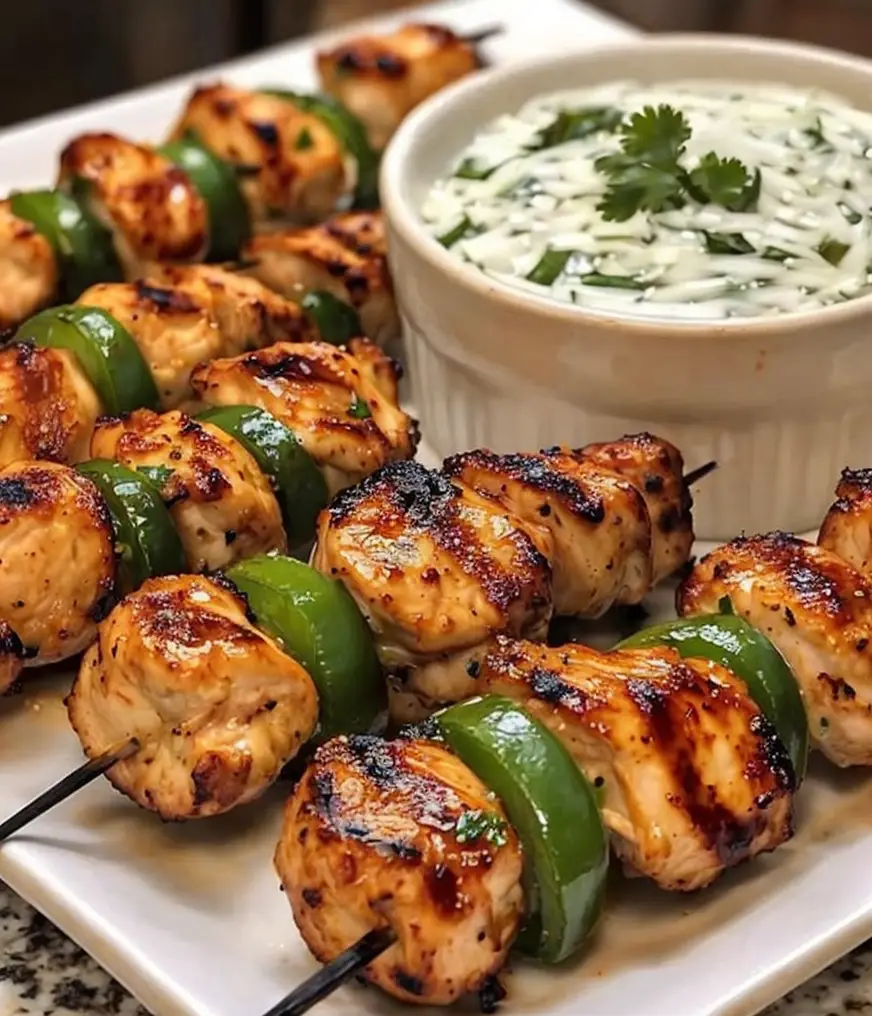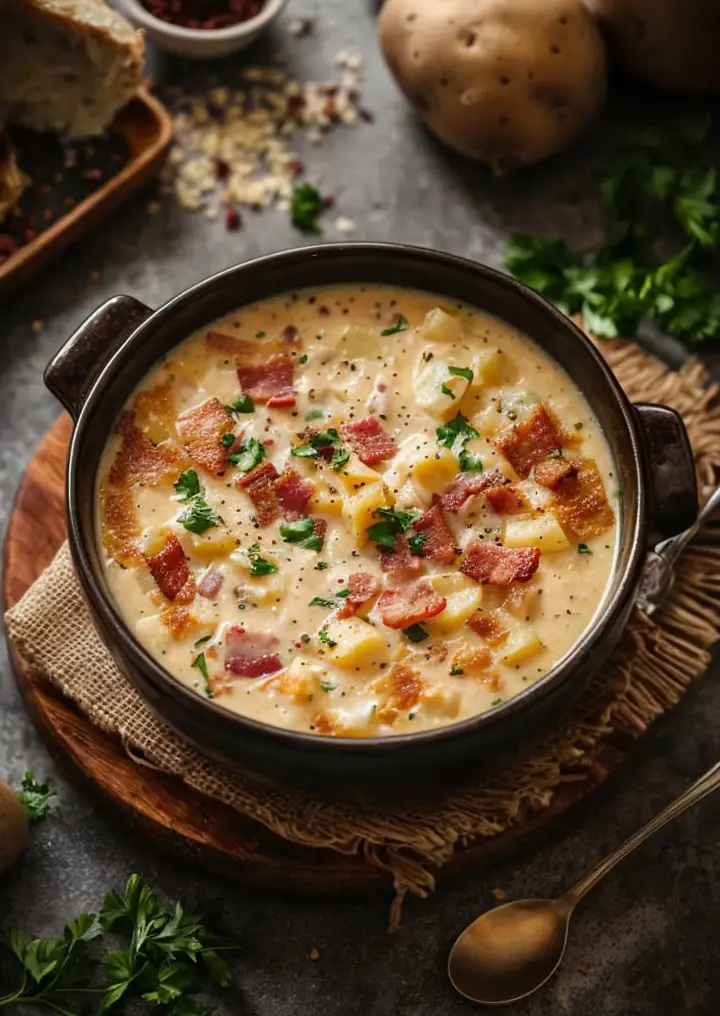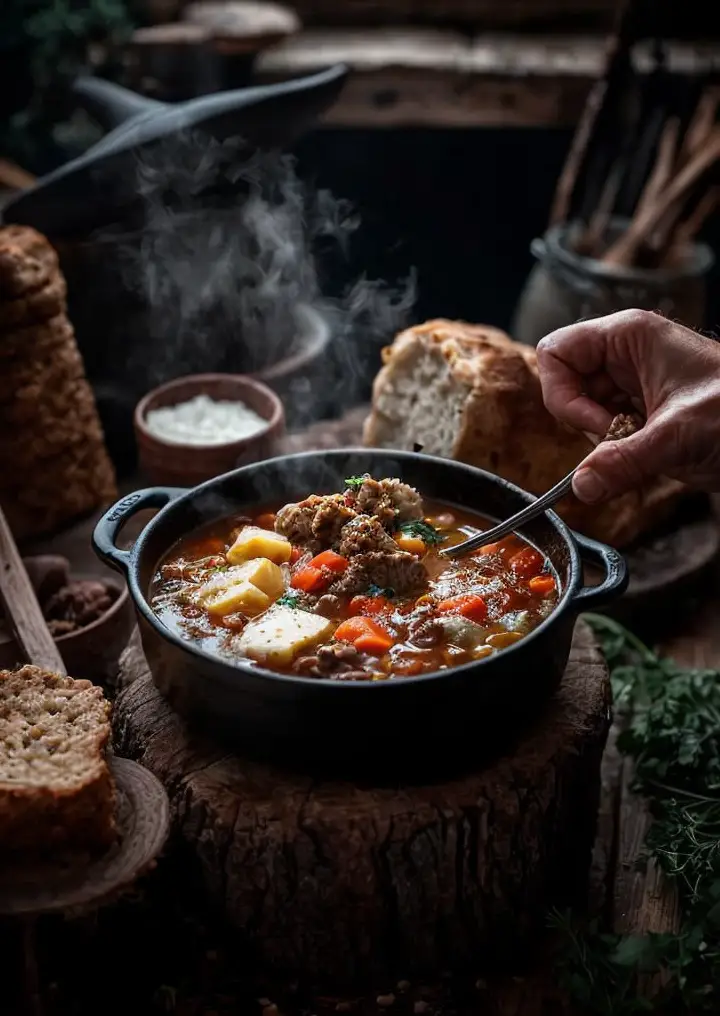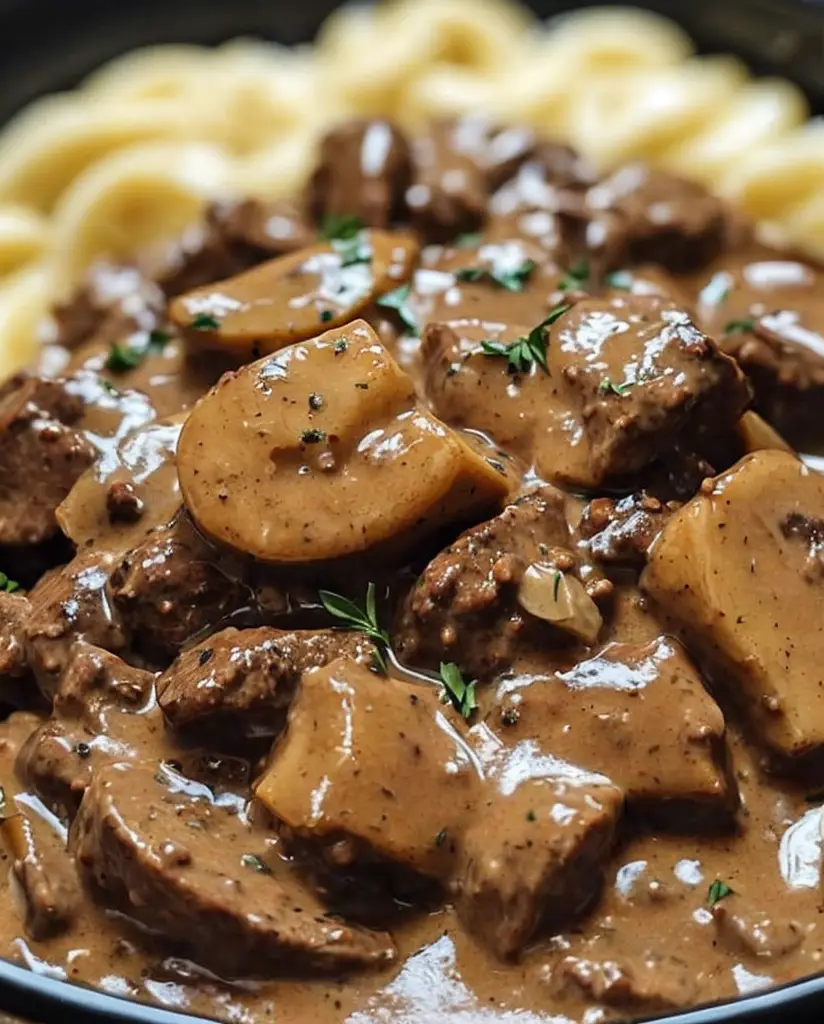Spicy Honey Jalapeño Chicken Skewers: A Sweet and Fiery Delight
Get ready to tantalize your taste buds with our Spicy Honey Jalapeño Chicken Skewers! This recipe combines the sweet and sticky goodness of honey with the fiery kick of jalapeños, making for a mouthwatering dish that’s perfect for summer grilling or a cozy family dinner. The succulent chicken mingles beautifully with the zesty marinade, ensuring every bite is bursting with flavor. Whether you’re hosting a casual backyard BBQ or prepping a satisfying weekday meal, these skewers are sure to impress and become a family favorite.
The marriage of sweetness from the honey and the heat from the jalapeños creates a sophisticated flavor profile that is both addictive and satisfying. As you grill, the aromas wafting through the air will spark excitement, and the vibrant colors of your skewers will make for an eye-catching dish that begs to be shared. These skewers are not only delicious but also incredibly easy to prepare, making them perfect for both novice cooks and seasoned chefs alike.
Quick Recipe Highlights
- Flavor Profile: This dish boasts a delightful blend of sweet, spicy, and savory flavors that dance on your palate, with honey balancing out the heat from the jalapeños.
- Texture: The chicken remains tender and juicy while the slightly charred edges add a satisfying crunch, creating a delightful contrast in every bite.
- Aroma: Expect a fragrant mix of caramelized honey and spicy jalapeños that will fill your kitchen and draw your guests towards the grill.
- Visual Appeal: The skewers flaunt a gorgeous golden-brown color, speckled with bright green from the jalapeños, creating a visually stunning dish.
- Skill Level Needed: This recipe is easy to follow, making it accessible for beginner cooks looking to elevate their culinary skills.
- Special Equipment: A grill or grill pan is essential for achieving that perfect char and smoky flavor that defines these chicken skewers.
Recipe Overview
- Difficulty Level: With only a few simple steps involved, making Spicy Honey Jalapeño Chicken Skewers is straightforward. It requires minimal cooking techniques, making it perfect for beginners.
- Category: This dish fits perfectly into the categories of appetizers, main dishes, and finger foods, making them versatile for various meal occasions.
- Cuisine: Rooted in fusion cuisine, this recipe brings together elements from Mexican and American traditions, celebrating bold flavors and communal eating.
- Cost: The approximate cost of this recipe is budget-friendly, typically ranging from $10 to $15, depending on local pricing of ingredients.
- Season: Ideal for warmer months, these skewers shine at summer cookouts, but they can also be enjoyed year-round for any festive gathering.
- Occasion: Perfect for outdoor BBQs, parties, and casual gatherings, they can also be served at family dinners or game day celebrations.
Why You’ll Love This Recipe
The combination of sweet and spicy is incredibly appealing, with the honey providing a luscious glaze that complements the juicy chicken and fiery jalapeños. The skewers have a tender texture which is inviting, and when grilled to perfection, they have just the right amount of char that enhances their flavor profile. This dish is easy to prepare, making it convenient for cooks who want delicious results without spending hours in the kitchen.
In terms of nutrition, chicken is a great source of lean protein, while jalapeños may offer health benefits including improved metabolism and potential anti-inflammatory properties. Enjoying these skewers is a fun way to savor healthy ingredients without compromising on taste. Not to mention, they present beautifully, making them a fantastic centerpiece for social gatherings, where they can be easily shared amongst guests.
Cost-effectiveness is also a highlight here. Using affordable ingredients while achieving a gourmet feel means you can delight your friends and family without breaking the bank. The ability of the skewers to cater to various diets makes them a universally loved dish, ensuring that everyone at your gathering can enjoy them.
Historical Background and Cultural Significance
The origin of chicken skewers can be found in various cultures around the world, with many regions utilizing skewers for grilling meats. The blend of spicy and sweet elements in this recipe is reminiscent of traditional dishes found in Mexico, where jalapeños are a staple ingredient. The simplicity and versatility of skewered foods have made them popular throughout history for their ease of preparation and communal presentation.
In Mexican cuisine, the use of ingredients like jalapeños and honey reflects regional flavors that highlight the nation’s love for balance in taste. Historically, grilling over an open flame has been a method for preserving meats and vegetables, making these skewers a dish rich in tradition and culture.
Over the years, variations of chicken skewers have evolved, incorporating different spices, marinations, and side dishes based on personal preferences and regional ingredients. Each iteration tells a story, making them a dish that transcends borders and celebrates diversity in culinary experiences.
Regional variations can be found where the spice level or accompanying elements change, catering to local palates. This adaptability of the recipe not only makes it significant in various cultures but also enhances its popularity among food lovers around the globe.
Ingredient Deep Dive
Chicken, as the main ingredient, has significant cultural relevance, being one of the most widely consumed meats globally. It serves as an excellent source of protein and is versatile in many cuisines. When selecting chicken, it’s advisable to look for high-quality, free-range options where possible. For storage, keep chicken refrigerated and consume within a few days, or freeze it for later use. If you prefer, it can be substituted with turkey or tofu for a different take.
Jalapeños are another star of this recipe, known for their vibrant flavor and health benefits. They contain capsaicin, which may provide health benefits such as pain relief and improved digestion. When choosing jalapeños, select firm, unblemished peppers, as they tend to be fresher and more flavorful. Store them in the refrigerator to maintain their crispness. If jalapeños are too hot for your taste, consider using milder peppers or omitting them altogether, customizing the heat to your preference.
Common Mistakes to Avoid
- Not marinating long enough – Ensure your chicken is marinated for at least 30 minutes for maximum flavor infusion.
- Using wooden skewers without soaking – Soak wooden skewers in water for at least 30 minutes to prevent them from burning on the grill.
- Overcrowding the skewers – Allow enough space between the pieces to ensure even cooking and thorough browning.
- Incorrect temperature for grilling – Preheat the grill to medium-high heat for the best sear and to lock in flavors.
- Not checking for doneness – Chicken should be cooked to an internal temperature of 165°F. Use a meat thermometer to ensure safety.
- Skipping the resting time – Letting the skewers rest after grilling allows juices to redistribute, keeping the meat tender.
- Overbasting with marinade – Use the marinade primarily for marinating rather than repeated basting while grilling to prevent flare-ups.
- Failing to adjust for variations in jalapeño heat – Remember that jalapeños can vary in heat level; taste them before using to adjust the quantity accordingly.
Essential Techniques
Marinating chicken is crucial for enhancing flavor and moisture. Allowing the chicken to soak in a mixture of honey, jalapeños, and spices adds depth to the dish. To master marinating, aim for at least an hour and the longer, the better. Be mindful of the marinade’s acidity, as overly potent acidic ingredients could lead to mushy chicken.
Grilling is where the magic happens. Achieving the perfect grill marks and smoky flavor enhances the sensory experience of your skewers. Ensure your grill is preheated and clean to prevent sticking. Look for visual cues such as a nice char and clear juices flowing to know when your chicken is ready to come off the grill. Pay attention to the flare-ups from dripping marinade and adjust cooking techniques accordingly.
Pro Tips for Perfect Spicy Honey Jalapeño Chicken Skewers
1. For extra flavor, consider adding fresh herbs like cilantro or parsley to your marinade.
2. Alternate your chicken with colorful vegetables like bell peppers, onion, or zucchini for added variety and nutrition.
3. Preheat your grill thoroughly to establish a nice sear on your skewers.
4. Baste your skewers with extra marinade during grilling to amplify flavors, but ensure you do so safely to avoid cross-contamination.
5. Experiment with different sauces after grilling, such as barbecue or ranch, for added flavor layers.
6. Before serving, sprinkle some lime juice over the skewers to enhance the flavors and add a refreshing touch.
7. Use citrus zest in your marinade for a brightness that balances the heat of the jalapeños.
8. Allow your skewers to rest for a few minutes after grilling before serving to optimize juiciness.
Variations and Adaptations
Explore regional variations like adding different cultural spices such as cumin or paprika to the marinade to give it a unique twist. Seasonal adaptations can include grilled summer vegetables like corn or squash for a vibrant dish bursting with color. For dietary modifications, swap out chicken for shrimp or tofu, maintaining the same marinade for a different protein experience.
You can also adjust the flavor profile by experimenting with different heat levels by incorporating spicier peppers or a spicy sauce. Texture modifications can include blanching vegetables slightly before grilling to ensure a tender crunch while keeping the skewers intact. For presentation, consider arranging skewers on a platter with colorful dipping sauces for an interactive dining experience.
Serving and Presentation Guide
When plating the Spicy Honey Jalapeño Chicken Skewers, consider arranging them vertically in a tall glass for a stunning visual display. Garnishing with fresh cilantro or green onions not only adds color but also enhances aroma. Traditional accompaniments like lime wedges serve to brighten the flavors when squeezed over the cooked skewers.
For modern servings, consider incorporating fancy toothpicks or mini skewers for cocktail parties or appetizer trays. Temperature is key; serve the skewers warm off the grill alongside cooling dips like yogurt-based sauces to balance the heat of the dish. Remember portion control as well—3-4 pieces per person can ensure everyone has enough to enjoy while allowing for a variety of other dishes.
Wine and Beverage Pairing
When it comes to wine pairings, a chilled Riesling or an off-dry Sauvignon Blanc complements the spicy and sweet flavors beautifully. For those who prefer cocktails, a light mojito or a spicy margarita can add an extra kick while balancing the heat. Non-alcoholic options may include sparkling water with lime for refreshing sips or a mocktail with fruit juices and soda water.
If coffee or tea is more your style, a lightly brewed iced tea can serve as a refreshingly sweet counterpart to the heat of the skewers, especially if infused with honey or mint. Ensure that beverages are chilled and served in ample quantities for guests to enjoy with their skewers.
Storage and Shelf Life
To store leftovers of Spicy Honey Jalapeño Chicken Skewers, place them in an airtight container and refrigerate for up to two days. For longer storage, they can be frozen for up to three months. Ensure they’ve cooled down before placing them in the freezer to maintain quality. When reheating, use an oven or grill to restore the skewer’s integrity, avoiding a microwave which could make them rubbery.
Check for spoilage by ensuring there are no off smells or discolorations after thawing. When reheating, heat to an internal temperature of 165°F to guarantee safety. If you’ve made extra marinade, consider using it as a base sauce while reheating for added flavor enhancement.
Make Ahead Strategies
To streamline your cooking process, consider marinating the chicken a day in advance, allowing flavors to develop fully. Store the marinated chicken in the refrigerator until you’re ready to grill. If preparing skewers ahead of time, assemble them but wait to grill until shortly before serving to maintain the juiciness of the chicken and the texture of the vegetables.
For an optimal dining experience, consider serving fresh components, such as herbs or garnishes, separately to be added just before eating. Adjusting this way preserves their freshness and enhances the end presentation, ensuring that flavors pop at the time of serving.
Scaling Instructions
To halve the recipe, simply divide all ingredients by two, which works seamlessly for the marinade and chicken. For those wanting to double or triple the recipe, ensure you have adequate skewers and space on the grill. Be mindful of adjusting cook times based on the increased volume; larger batches may require longer cooking times to reach the appropriate internal temperature.
When scaling, also consider the dimensions of your grill and whether you need to cook in batches to maintain even cooking and avoid crowding. Storage considerations remain the same; keeping leftovers in airtight containers allows for easy reheating and enjoyment later.
Nutritional Deep Dive
Analyzing the macro breakdown of Spicy Honey Jalapeño Chicken Skewers reveals a high protein content due to the chicken, coupled with carbohydrates from the honey. This dish is relatively low in fat, making it a healthy choice suitable for various diets. Furthermore, chicken breast provides essential amino acids for muscle repair and growth, while jalapeños may support metabolism with their heat components.
Micronutrient analysis shows that this recipe offers vitamins and minerals such as vitamin C from jalapeños and B vitamins from chicken. Being mindful of portion sizes allows for enjoyment without overindulgence. Overall, this dish can be a smart addition to a weight management regimen when paired with a variety of sides like grilled vegetables or a fresh salad.
Dietary Adaptations
This recipe can easily be made gluten-free by checking all marinade ingredients to ensure they contain no gluten. For those with dairy restrictions, simply using an oil-based marinade keeps it compliant. To cater to vegan diets, swap the chicken for firm tofu or tempeh while using the same spicy marinade, allowing flavors to penetrate the meat alternatives effectively.
For low-carb or keto-friendly variations, consider using zucchini noodles or grilled vegetables in place of traditional side dishes. You can also omit the honey or use a sugar substitute to keep things keto while still maintaining the sweet-heat balance. These adaptations prevent exclusion while ensuring the recipe fits various dietary needs.
Troubleshooting Guide
If you encounter texture issues with your chicken skewers, ensure you’re not overcooking them. Always check the internal temperature to prevent dryness. If your flavors are unbalanced, adjust before serving using lime juice to add brightness or honey to enhance sweetness as necessary.
For problems with uneven cooking, ensure your grill is preheated sufficiently and that skewers are spaced appropriately to allow heat circulation. Equipment challenges like flare-ups can be mitigated by managing the heat level of your grill and moving skewers away from direct flames when necessary.
Recipe Success Stories
Community feedback on the Spicy Honey Jalapeño Chicken Skewers has been overwhelmingly positive, with many home cooks praising the ease and flavorful result. Some have shared variations, adding their choice of herbs or marinating the chicken overnight to boost flavor intensity. Adaptation stories include using different proteins, such as shrimp, resulting in delightful seafood skewers filled with the same sweet and spicy notes.
Readers have also contributed to photography tips that enhance the visual appeal of the finished dish, emphasizing the vibrant colors of jalapeños and grilled chicken. Many enjoyed sharing their success with friends and family, making these skewers a centerpiece for summer gatherings and social events.
Frequently Asked Questions
Q: Can I use other meats for this recipe?
A: Absolutely! This marinade works wonderfully with pork, shrimp, or even tofu for a vegetarian option. Adjust cooking times accordingly for different proteins.
Q: How do I store leftovers of the skewers?
A: Store them in an airtight container in the refrigerator for up to two days. You can also freeze them for up to three months.
Q: What can I serve with these skewers?
A: These skewers pair perfectly with a fresh green salad, grilled vegetables, or a side of rice or quinoa for a complete meal.
Q: Can I make the marinade ahead of time?
A: Yes, the marinade can be prepared up to a week in advance and stored in the refrigerator for convenience.
Q: What variations can I experiment with in the marinade?
A: Feel free to switch up spices or add extra elements like lime zest, cilantro, or even sriracha for an extra kick.
Q: How do I ensure my jalapeños are not too spicy?
A: Remove the seeds and inner membranes of the jalapeños before adding them to the marinade, as these parts contain the majority of the heat.
Q: Is it better to grill or bake the skewers?
A: Grilling provides a smoky flavor and desirable char, but baking is still an option. If baking, use a high temperature for best results.
Q: Can I use pre-cut chicken for the skewers?
A: Yes, pre-cut chicken works well and saves prep time, but ensure it’s consistent in size for even cooking.
Q: What can I do if my skewers are drying out on the grill?
A: Make sure to not overcook the skewers and use a marinade to baste them as they cook, helping retain moisture.
Q: Can I grill from frozen?
A: It’s best to thaw the skewers in the refrigerator overnight for even cooking. Grilling from frozen may lead to uneven cooking.
Additional Resources
For more delicious and creative recipes, check out our section on grilled dishes and barbeque favorites. For beginners, our technique guides can help you master grilling skills and marinades, ensuring that your chicken skewers come out perfect every time.
Looking to dive deeper into ingredient information? We have in-depth articles exploring the health benefits of honey, the nutritional advantages of chicken, and even more on jalapeños. Don’t forget to explore the equipment recommendations to find the best grills or tools to use for your cooking adventures.
Join the Conversation
We encourage our readers to share their photos and experiences with Spicy Honey Jalapeño Chicken Skewers on social media. Tag us in your delicious creations and inspire others with your unique twists on the classic recipe! Feedback is invaluable, so leave comments about your experiences—whether it be praise, adjustments, or personal stories tied to this scrumptious dish.
The Recipe
Spicy Honey Jalapeño Chicken Skewers
Serves: 4
Prep Time: 20 mins
Cook Time: 15 mins
Total Time: 35 mins
Kitchen Equipment Needed
- Grill or grill pan
- Wooden or metal skewers
- Measuring cups and spoons
- Mixing bowl
- Brush for basting
Ingredients
- 1 lb. chicken breast, cut into 1-inch cubes
- 2-3 jalapeños, seeded and chopped
- 1/4 cup honey
- 2 tablespoons olive oil
- 2 tablespoons soy sauce (or tamari for gluten-free)
- 1 teaspoon garlic, minced
- 1 teaspoon lime juice
- Salt and pepper to taste
- Wooden skewers, soaked in water for 30 minutes
Directions
- In a mixing bowl, combine honey, olive oil, soy sauce, minced garlic, lime juice, jalapeños, salt, and pepper.
- Add chicken cubes to the marinade. Mix well, ensuring each piece is coated. Let marinate for at least 30 minutes (or up to overnight in the refrigerator).
- Preheat the grill to medium-high heat. Thread marinated chicken onto skewers, leaving a little space between each piece.
- Place skewers on the grill. Grill for about 5-7 minutes on each side or until the chicken is cooked through and has nice grill marks (internal temperature should reach 165°F).
- Remove skewers from the grill and let them rest for a few minutes before serving.
Recipe Notes
- Feel free to adjust the number of jalapeños based on your heat preference.
- Add vegetables like bell peppers or onions onto the skewers for extra flavor and nutrition.
- Extra marinade can be brushed over the skewers while grilling for enhanced flavor.




